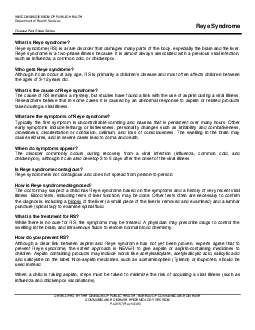

What is Reye syndrome Reye syndrome RS is a rare disorder that damages many parts of the body especially the brain and the liver Reye syndrome is a twophase illness because it is almost always associ ID: 881882
Download Pdf The PPT/PDF document "WISCONSIN DIVISION OF PUBLIC HEALTH Depa..." is the property of its rightful owner. Permission is granted to download and print the materials on this web site for personal, non-commercial use only, and to display it on your personal computer provided you do not modify the materials and that you retain all copyright notices contained in the materials. By downloading content from our website, you accept the terms of this agreement.
1 WISCONSIN DIVISION OF PUBLIC HEALTH Depa
WISCONSIN DIVISION OF PUBLIC HEALTH Department of HReye Syndrome What is Reye syndrome? Reye syndrome (RS) is a rare disorder that damages many parts of the body, especially the brain and the liver. Reye syndrome is a two-phase illness because it is almost always associated with a previous viral infection, such as influenza, a common cold, or chickenpox. Who gets Reye syndrome? Although it can occur at any age, RS is primarily a children’s disease and most often affects children between the ages of 3-12 years old. What is the cause of Reye syndrome?The cause of RS remains a mystery, but studies have found a link with the use of aspirin during a viral illness. Researchers believe that in some cases it is caused by an abnormal response to aspirin or related products taken during a viral illness. What are the symptoms of Reye syndrome? Typically the first symptom is uncontrollable vomiting and nausea that is persistent over many hours. Other early symptoms include lethargy or listlessness, personality changes such as irritability and combativeness, drowsiness, disorientation or confusion, delirium, and loss of consciousness. The swelling in the brain may cause seizures, and in severe cases lead to coma and death. When do symptoms appear? The disorder commonly occurs during recovery from a viral infection (influenza, common cold, and chickenpox), although it can also develop 3 to 5 days after the onset of the viral illness. Is Reye syndrome contagious? Reye syndrome is not contagious and does not spread from person-to-person. How is Reye syndrome diagnosedThe doctor may suspect a child has Reye syndrome based on the symptoms and a history of very recent viral illness. Blood tests, including tests of liver function, may be done. Other tests often are necessary to confirm the diagnosis, including a biopsy of the liver (a small piece of the liver is removed and examined) and a lumbar puncture (spinal tap) to examine spinal fluid. While there is no cure for RS, the symptoms may be treated. A physician may prescribe drugs to control the swelling in the brain, and intravenous fluids to restore normal blood chemistry. How do you prevent RS? Although a clear link between aspirin and Reye syndrome has not yet been proven, experts agree that to prevent Reye syndrome, the safest approach is NEVER to give aspirin or aspirin-containing medicines to children. Aspirin containing products may include words like acetylsalicylate, acetylsalicylic acid, salicylic acid and salicylate on the label. Non-aspirin medicines, such as acetaminophen (Tylenol) or ibuprofen, should be used instead. When a child is taking aspirin, steps must be taken to minimize the risk of acquiring a viral illness (such as influenza and chickenpox vaccinations). DEVELOPED BY THE DIVISION OF PUBLIC HEALTH, BUREAU OF COMMUNICABLE DISEASE COMMUNICABLE DISEASE EPIDEMIOLOGY SECTION P-42157 (Rev 10/05)